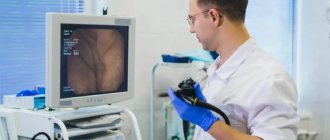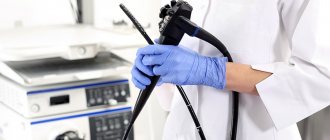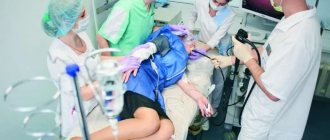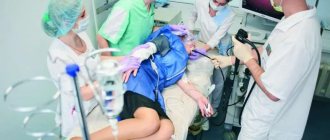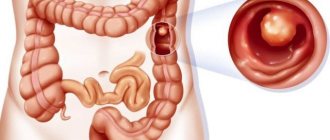Colonoscopy is one of the most complex and lengthy endoscopic examinations (average duration is 30 minutes). It allows you to assess the condition of the colon, detect certain problems in time and take the necessary measures to eliminate them.
Depending on the findings, an examination can be carried out in a narrow spectrum of light and with magnification, which expands the diagnostic capabilities of the procedure, and a biopsy (sampling of small pieces of the mucous membrane for histological examination) can be performed.
During a colonoscopy, air is introduced into the intestine, so you may feel bloating, a false urge to defecate, and other unpleasant sensations. Sometimes they can be painful, which primarily depends on the anatomy of the intestine and the quality of preparation. However, severe pain is usually not observed.
Today we recommend conducting the examination under anesthesia - this relieves the patient of anxiety and discomfort, and gives the specialist the opportunity to do his job carefully and obtain maximum information.
In any case, it is very important to prepare for the study correctly.
Diet before colonoscopy
You must follow a slag-free diet for 3 days before the test. Note that we are not talking about a therapeutic diet, “good” and “bad” foods. The point is that for these 3 days even some healthy foods are excluded - primarily those rich in fiber, because they contribute to the formation of feces.
It is forbidden:
cereals (porridge, baked goods), vegetables and fruits - in any form, legumes, seeds, nuts.
Can:
pasta, potatoes, meat, fish, dairy products, chocolate.
The last meal is no later than 1-2 hours before the start of immediate preparation for the procedure.
Method of use of Lavacol and dose
Dilute the contents of 1 sachet of the drug in 1 glass of water (200 ml) at room temperature. You can add syrup or jam to the resulting solution (to adjust the taste).
Take the prepared solution 200 ml every 20-30 minutes.
The solution can be washed down with water or water with lemon. The stool begins to pass 1-1.5 hours after starting to take the drug and stops 1-3 hours after taking the last dose of the drug.
There are two ways to take the drug, one-stage and two-stage:
If the study is scheduled for 8-10 am, then the drug should be taken from 16.00-17.00 to 21.00-22.00 the night before. After 10 pm, eating is not recommended.
An examination (colonoscopy) is possible no earlier than 4 hours after the last dose of the drug.
What medications are used to prepare for the procedure?
To prepare for a colonoscopy, we prescribe✽:
- Laxative is a powder from which a solution is prepared. Its active ingredient, macrogol, is included in many modern laxatives. Macrogol is safe: it is not absorbed in the gastrointestinal tract, so it does not enter the blood, and therefore does not have a systemic effect on the body.
- Defoamer (a means to reduce gas formation) in emulsion or drops. Its active ingredient, simethicone, allows the use of such products even for newborns.
✽If you suffer from chronic constipation, you will need a longer diet (5 days before the study). It should be accompanied by the laxatives you usually use.
The solution must be prepared immediately before use. The rules for its preparation (dosage, etc.) are indicated in the instructions for the specific drug, but in general the preparation regimens are the same.
General information about the drug
Registration number: R№ LS - 000443
Trade name: Lavacol®
Dosage form: Powder for the preparation of solution for oral administration.
Composition per package (14.0 g):
- Polyethylene glycol MM 4000 - 12.0 g
- Sodium sulfate anhydrous - 1.0 g
- Sodium bicarbonate - 0.6 g
- Sodium chloride - 0.2 g
- Potassium chloride - 0.2 g
Description:
Powder of white or white with a yellowish or grayish tint. One packet of the drug is dissolved in 200 ml of water. The resulting solution is a colorless or slightly colored liquid, slight opalescence is allowed.
Pharmacological properties:
The action of the drug is based on the combination of a high molecular weight polymer with an isotonic solution of electrolytes. Polyethylene glycol MM 4000 prevents the absorption of water from the stomach and intestines and promotes accelerated evacuation of intestinal contents through frequent bowel movements. The electrolytes contained in the drug prevent disturbances in the body's water-electrolyte balance.
Indications for use:
Preparation for endoscopic or x-ray examination of the colon, as well as for surgical interventions that require the absence of contents in the intestine.
Contraindications:
Severe disturbances in the patient's general condition (including dehydration, heart failure), intestinal obstruction, toxic expansion of the colon, gastric stenosis, perforation of the stomach or intestines, erosive and ulcerative lesions of the gastrointestinal tract, impaired renal function.
Side effect:
In rare cases, nausea and vomiting, a feeling of heaviness and discomfort are possible when taking the first doses of the drug.
Release form:
Powder in bags of 14 g of combined film material. 15 bags, along with instructions for use, are placed in a cardboard pack.
It is allowed to pack packages together with an equal number of instructions for use in a group package.
Storage conditions:
At a temperature not exceeding 25°C, in a dry place out of reach of children.
Best before date:
3 years. Do not use after the expiration date stated on the package.
How to take the solution?
Scheme No. 1 (study in the morning the next day):
- the entire volume of the solution should be taken the evening before the test; add 1/3 bottle of defoamer to the last liter of solution;
- You also need to drink a certain volume (depending on the drug) of clear liquid - water, clarified juice, green or weak black tea, broth.
Scheme No. 2 (study during the day the next day):
- half the volume of the solution should be taken the evening before the test;
- you also need to drink a certain volume (depending on the drug) of a clear liquid - water, clarified juice, green or weak black tea, broth;
- take the last liter of solution with an antifoam agent added to it (1/3 of the bottle) in the morning on the day of the study;
- drink the required amount of clear liquid.
In general, during preparation you should drink at least 1.5 liters of liquid (in addition to the solution itself).
During preparation, it is advisable to maintain physical activity - for example, walking around the apartment.
You must stop taking all liquids no later than 2 hours before the start of the procedure (clarification for colonoscopy, which is performed under anesthesia, see below).
Choosing a regimen for taking MOVIPREP® depending on the time of the examination.
Two-stage scheme (1 liter of MOVIPREP® solution is taken in the evening before the examination day and 1 liter in the morning on the examination day):
- 19:00 - 20:00 take the first liter of MOVIPREP® solution.
- Take 500 ml of permitted liquid.
- 6:00 - 7:00 take the second liter of MOVIPREP® solution.
- Take 500 ml of permitted liquid.
One-stage scheme
(2 liters of MOVIPREP® solution are taken the evening before the examination):
- 18:00 - 19:00 take the first liter of MOVIPREP® solution.
- Take 500 ml of permitted liquid.
- 19:00 - 20:00 take the second liter of MOVIPREP® solution.
- Take 500 ml of permitted liquid.
If you have any difficulties
You should not force the process! If you have a feeling of fullness in your stomach, take a short break and slightly lengthen the time you take the solution.
Also, to facilitate the preparation process, it is recommended to cool the solution a little and/or drink it through a cocktail straw. You can add citrus juice without pulp or drink the solution with it. You can suck (but not eat!) an orange or tangerine, or sour candies.
In case of delayed action of the solution, massage the stomach clockwise.
Can:
- Soups with low-fat meat broth without vegetables, dishes made from lean beef, veal, fish, boiled chicken, eggs;
- Products rich in calcium (low-fat cottage cheese, cheeses), kefir, natural yogurt, no more than 2 glasses of milk;
- White bread, muffins, biscuits, bagels - without poppy seeds, vermicelli and noodles made from premium flour, porridge (rice and oatmeal), white rice;
- Vegetable decoctions, potatoes, mousses, peaches, melon, compotes, jelly, juices (without pulp), weak coffee, tea;
- Sugar, honey, jellies, syrups;
- Butter and vegetable oil, margarine, mayonnaise in limited quantities.
If the examination is performed under anesthesia
- We use modern and safe anesthetic agents. During the procedure, constant monitoring of the patient’s cardiovascular and respiratory systems is carried out. For competent management of anesthesia, it is mandatory to have an electrocardiogram (ECG) no more than 10 days old. If the patient wishes, an ECG can be performed immediately before the colonoscopy in our institution.
- On the morning of the test, no liquids should be taken (planned medications should be taken with a minimum amount of water).
- Most patients tolerate intravenous anesthesia well, but it is still highly advisable to have someone accompany you on the day of the procedure. In any case, after the research, you cannot drive the car yourself!
Colonoscopy is performed by specialists from the interventional endoscopy group using the latest generation diagnostic equipment.
New schemes for bowel preparation for colonoscopy
The effectiveness of colonoscopy and the detection of intestinal pathology during its implementation largely depend on the quality of intestinal cleansing. Inadequate preparation of the intestine for examination may cause the endoscopist to miss any pathological focus. This, in turn, can cause untimely diagnosis of many serious diseases, including colon cancer, and, as a result, the cost of additional funds for re-preparing the patient for the study and the actual repeat colonoscopy itself. Despite the understanding of the importance of adequate bowel preparation by all stakeholders - gastroenterologists referring patients for examination, medical staff of departments, patients, in daily clinical practice endoscopists regularly encounter poor visualization during colonoscopy. Currently, on the domestic pharmaceutical market there is a fairly large number of different products, the use of which can qualitatively cleanse the intestines for carrying out a full-fledged endoscopic or any other instrumental examination or surgical intervention. Adequate bowel preparation should be properly motivated by doctors in front of patients, in order for them to comply with the diet and regimen of taking a cleanser, chosen for each patient personally.
The number of diagnostic and therapeutic endoscopic examinations of the colon has increased significantly in recent years. At the same time, the capabilities of colonoscopy itself have increased significantly. The quality of endoscopes is improving, and it has become possible to examine the mucous membrane in high-definition (HD) conditions, using narrow-spectrum lighting and magnifying (ZOOM) endoscopy [1]. Currently, colonoscopy is the leading research method in the diagnosis and differential diagnosis of inflammatory bowel diseases, identifying polyps of the large and small intestine, and diverticulosis. Colonoscopy is an indispensable diagnostic method when conducting national screening programs for the early detection of colorectal cancer. The technical capabilities of endoscopy, and even more so the combination of colonoscopy with confocal microscopy, currently make it possible to determine areas of mucosal dysplasia in developing adenomas literally at the cellular level, accurately localizing the lesion with an error of just a few microns. However, such possibilities of endoscopic examination can only be realized in the presence of a clean intestinal mucosa, freed from various organic deposits and foamy contents [2, 3]. Adequate bowel cleansing is especially important when examining the right parts of the colon, where it is technically more difficult to diagnose early forms of malignant neoplasms and (or) flat, serrated neoplasms [4–7]. In addition, insufficient quality of bowel cleansing often leads to forced interruption of an already started colonoscopy, which in turn leads to additional costs for re-preparing the patient for colonoscopy and the actual endoscopic examination itself [1–3]. Re-referring a patient for a colonoscopy, additional time spent on bowel preparation, and performing a repeat colonoscopy itself may carry an unjustified risk and, as a result, late diagnosis of the pathological process.
Despite the obvious importance of high-quality bowel preparation for colonoscopy, in daily practice, unfortunately, it does not always meet the requirements. Insufficient bowel cleansing can cause tumors to “miss.” Thus, according to P. A. Nikiforov, 28 out of 377 patients a year after colonoscopy were diagnosed with stage II or III cancer, and in 34 - stage I cancer, which indirectly indicates that this pathology was missed during the initial examination due to inadequate preparation [8]. Almost the same results are reported by Lebwohl et al. based on an analysis of the work of the endoscopy department of a large multifunctional clinic, where out of 12,787 colonoscopies, bowel preparation was insufficient in 24% of patients [9]. Of note is the fact that only 17% of patients with initial inadequate bowel preparation underwent repeat endoscopy in the next 3 years. Of the 198 adenomas identified in this study, 42% were detected only at repeat colonoscopy.
The challenge in ensuring good bowel preparation is multifactorial. Only by taking into account all the components of this process can the proper quality of the intestinal condition and effective endoscopic examination be achieved.
One of the main components of solving this problem is, strange as it may sound, the patients themselves who are about to undergo a colonoscopy. In addition, the patient factor consists of two parts - subjective, which directly depends on the patient’s behavior, and objective, independent of the behavioral and psycho-emotional state of patients. Before the study, patients do not always adhere to the recommended diet and use of bowel cleansing agents. Even if the most effective existing means of bowel cleansing is used in patients who have violated their diet to one degree or another during the period of preparation for colonoscopy, the result of bowel cleansing may be negative. It is extremely important to convey to the patient, through the mouth of the doctor, medical personnel, or with the help of visual aids and materials, information about the need for strict adherence to diet and dietary restrictions, which are (usually) not so critical for lifestyle, but are extremely important for the quality of bowel preparation. But even if patients fully understand the need to comply with dietary restrictions, their observance cannot be guaranteed in all cases. In addition, the quality of bowel preparation in patients can be influenced not only by various errors in food, but also by objective factors. The overall result of the quality of bowel preparation can be influenced by multiple, at first glance insignificant, factors, for example, a sedentary lifestyle, sedentary work, difficult access to the toilet or limited fluid intake; even multi-bed rooms in clinics and hospitals can affect the psychological state patients and influence the quality of bowel preparation.
Another important component when cleansing the intestines is the correct choice of a drug that directly affects the contents of the intestine and evacuates it from the body. Each drug used in a given situation must meet certain requirements on the part of both research doctors and patients using it.
For endoscopists, it is important that the drug for bowel cleansing, when used, provides a clean mucous membrane without any residue of solid or liquid contents in the intestinal lumen, is well tolerated by patients and does not require additional monitoring of the health status of the subject.
On the other hand, the ideal drug for colon cleansing should not only meet the requirements of doctors, but also fully comply with the wishes of the patients taking this drug. It should have pleasant organoleptic properties with no adverse drug reactions (pain, nausea, vomiting) when taking it. In this case, preference is given to drugs that require less liquid to take, with minimal dietary restrictions and to a lesser extent change the normal rhythm and quality of life.
Currently, there are several groups of drugs on the pharmaceutical market intended for oral administration to prepare the intestines for instrumental studies. Each of these groups differs in the mechanism of action and, therefore, the effectiveness of the preparation. Unfortunately, none of the existing drugs is ideal in all respects, as evidenced by numerous clinical studies [9, 10]. Between different groups of drugs, even those that are similar in composition, there are noticeable differences in the quality of bowel preparation in terms of tolerability by patients [12].
The UK National Patient Safety Agency (NPSA) has issued guidelines for the safe use of oral bowel cleanses [13]. These guidelines make clear the possible clinical risks of using various oral colon cleanses. The recommendations, in particular, note that the decision to use a particular product should be made as responsibly as the decision to conduct an instrumental study itself, and all patients should fill out a written informed consent form to prevent possible risks when using oral cleansers . This guideline, as well as other recent meta-analyses, now focuses specifically on the safety of oral cleanses, provides guidelines for bowel preparation, absolute and relative contraindications for the use of various oral cleanses, and provides recommendations for the selection and use of these drugs in patients with various risk groups [14–17].
With any oral drug, no matter how effective, all bowel preparation efforts can be nullified if the patient does not follow a specific diet before starting preparation. For high-quality preparation, it is necessary to prescribe patients a slag-free diet for 2-3 days before starting bowel cleansing, so that there is as little dense undigested food residues in the intestinal lumen as possible. This provides the basis for subsequent effective lavage. In particular, foods that should be excluded from patients' diets include: vegetables (carrots, beets, cabbage, turnips, radishes, onions, garlic); herbs (sorrel or spinach); porridge, but not all (oatmeal, millet, pearl barley); legumes (peas, beans, lentils, beans); fruits (peach, apple, pear, bananas, tangerines, grapes, dried fruits); nuts of all varieties; any berries; rye bread, any products made from rye flour; dairy products (except fermented milk); fried, smoked meat, smoked sausages. These dietary restrictions are not critical for most patients, since dietary restrictions are recommended only for a short period of time, and besides, there remains a fairly large range of food products allowed for use: broths, eggs, semolina porridge, boiled meat and boiled sausage , cheese, butter, fermented milk products (but not cottage cheese), fish. On the day of the examination, you can only consume liquid food: tea, broth, mineral or boiled water, clear juices. In addition to the dietary restrictions that each patient must adhere to, depending on the type of cleansing drug used, there are absolute and relative contraindications for performing oral bowel preparation for colonoscopy. Thus, absolute contraindications include: suspicion of intestinal obstruction or perforation, obstruction of the gastrointestinal tract at any level, severe acute inflammatory bowel disease or toxic megacolon, impaired consciousness, hypersensitivity or allergic reaction to the components of the drug, difficulty swallowing and the inability to swallow without aspiration (in some cases, bowel cleansing can be done through a nasogastric (nasoduodenal) tube or other tube placed at the level of the duodenum). In this case, the preparation should be carried out in a hospital setting under the supervision of a doctor.
Relative contraindications for oral administration of bowel cleansing drugs are in patients undergoing hemodialysis or peritoneal dialysis, after a kidney transplant, suffering from chronic heart failure, cirrhosis of the liver and (or) having ascites. In these cases, you need to be very careful when choosing a cleanser and give preference to products based on polyethylene glycols.
Thus, drugs containing sodium sulfate and sodium phosphates, magnesium salts should be used with caution in patients with renal failure, liver cirrhosis, chronic heart failure, as there is a risk of developing water and electrolyte disorders.
Research to optimize bowel preparation processes continues to this day [18–21]. In healthy individuals, sodium phosphate-based preparations are currently recommended for use only in cases of individual intolerance to polyethylene glycol (PEG). In other cases, the drugs of choice currently remain those based on polyethylene glycols. But even in this case, there is quite a lot of freedom of choice among representatives of this series. Macrogol cleansers are currently available with molecular weights of 4000 and 3350. The differences in the molecular weight of the product component may seem minor, but these differences can have a significant impact on the quality of bowel preparation and the quality of life of patients.
For a long time, most experts gave preference to drugs based on macrogol 4000. Compared to drugs based on magnesium or sodium salts, these drugs are safe in relation to the state of the body’s water and electrolyte balance. They do not come into contact with the mucous membrane. Once in the lumen of the colon, macrogols form a gel-like substance that accumulates fluid located in the lumen of the intestine. In this case, the mechanoreceptors of the intestinal wall are irritated, peristalsis is activated and active cleansing of the intestine occurs. A significant disadvantage of Macrogol 4000 is the need for strong dilution of the drug and the intake of a significant volume of liquid when preparing for colonoscopy. On average, the volume of the cleansing agent is calculated from the ratio: 1 liter of macrogol 4000 solution per 20 kg of patient’s body weight. So, with an average weight of 70–75 kg, it is necessary to drink 4 liters of solution for adequate bowel preparation. In addition, the composition of the so-called first generation drugs, along with PEG, also includes some salts - in particular, potassium chloride, sodium chloride and sodium bicarbonate, designed to compensate for possible electrolyte losses. The presence of sodium sulfate in the composition of the drug (in various modifications up to 5.0 or 5.7 g) gives the solution a bitter-salty taste, which significantly reduces the organoleptic properties of the solution and can cause mild nausea and discomfort in some patients, especially when taking a large volume liquids.
At the Moscow Scientific Research Center we carried out research work on the use of a PEG solution with a lower molecular weight - macrogol 3350 (Endofalk). The drug is supplied in powder for preparing a solution. The isoosmotic solution of the drug consists of macrogol 3350, a mixture of electrolytes potassium and sodium chloride and sodium bicarbonate, which prevent the absorption of fluid in the lumen of the gastrointestinal tract. Silicon dioxide, also included in the mixture, has an antifoaming effect and prevents the development of flatulence. The use of PEG with a lower molecular weight made it possible to reduce the amount of stabilizing electrolytes, which improved the organoleptic properties of the drug. We observed 68 patients who underwent bowel preparation before colonoscopy. All patients were divided by blind randomization into two groups, the first included 29 people, the second 39 people. Both groups did not differ from each other in terms of gender and age. In order to determine the effectiveness of using PEG with a molecular weight of 3350, the first group of patients received a 3-liter Endofalk solution as preparation for colonoscopy, the second control group of patients received a 4-liter PEG solution with a molecular weight of 4000. Two days before the study, all patients followed a slag-free diet. The drug was taken before the study in two stages. Patients took the first portion of the drug in the evening before the study (starting at 18:00), the second portion - in the morning on the day of the study, 4 hours before the colonoscopy.
When taking the drug, the organoleptic properties and subjective sensations of patients were assessed in the form of a survey. The quality of bowel cleansing was assessed during colonoscopy using the international classification of bowel cleansing quality. Moreover, the study for endoscopists was blind, since they did not know which patient was prepared with which drug, and assessed the quality of bowel preparation only on the basis of objective criteria according to the Chicago Bowel Preparation Scale [22]. According to this classification, the large intestine is divided into three sections - left, middle and right. Each of the segments is assessed using a twelve-point system, to which is added a four-point gradation for assessing the amount of fluid in the intestinal lumen that is already present before the start of the study (Tables 1, 2).
Research results
Based on the results of colonoscopy performed by endoscopists, we did not note a significant significant difference in the quality of bowel preparation using Endofalk or macrogol 4000 solution.
Thus, in 87.4% of patients receiving Endofalk and 85.8% receiving Macrogol 4000, the degree of intestinal cleansing was 36 points; in 9.4% of patients in the first group and 7.6% in the second, the score corresponded to 32–34 points; in 3.2% of the first group of patients and 5.6% of the second group, the degree of intestinal cleansing was assessed within 28–31 points. In both groups, the amount of residual fluid was assessed as 0–1 point.
We noted the difference when taking different bowel preparation regimens during a survey of patients who assessed the taste of the solutions, the quality of night sleep, the number of bowel movements, the appearance of nausea, weakness, vomiting, thirst, dizziness, as well as during an objective and laboratory examination of patients in both groups for changes blood pressure, changes in basic indicators of acid-base balance.
As can be seen from table. 3, patients liked the taste of Endofalk more, which, according to some patients, has a pleasant taste of orange and passion fruit, compared to the bitter-salty taste of macrogol 4000, which is given to it by sodium sulfate in the solution (p < 0.05). The number of bowel movements during preparation with both drugs, as well as the quality of night sleep in both groups, was approximately the same, and we did not note a significant difference.
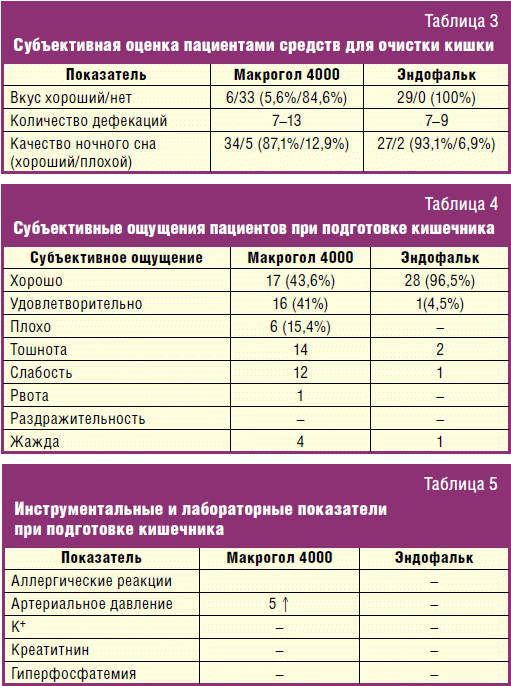
When assessing subjective feelings, the majority of patients in the first group liked Endofalk and rated it as “good” (96.5%), while less than half of the patients in the second group (43.6%) liked Macrogol 4000 (p < 0. 05). 41% of patients in the same group rated Macrogol 4000 “satisfactory” and 15.4% did not like it at all. Nausea while taking drugs was experienced by 14 people from the second group and 2 from the first; weakness while taking the drugs developed only in one patient when taking Endofalk and in 12 people taking Macrogol 4000. Also, only patients in this group experienced vomiting (1 patient). Thirst after taking the drugs was experienced by 4 patients of the second group and 1 patient while taking Endofalk.
When analyzing data from instrumental and laboratory studies, we noted only a slight increase in blood pressure values in 5 patients taking macrogol 4000, which did not affect the general condition of the patients. There were no changes in the acid-base status in any of the patients under our supervision.
The results of the study showed almost the same efficiency of intestinal cleansing when using traditional drugs based on macrogol 4000 and a new drug for Russia based on macrogol 3350 (Endofalk). However, Endofalk showed better organoleptic properties, and the smaller volume of liquid required when taking this drug allowed us to achieve better subjective sensations for patients compared to taking solutions of macrogol 4000. The results of our studies coincided with similar studies conducted in other countries [23, 24 ].
In addition to a comparative study of traditional bowel preparation, a small pilot study was conducted in a limited group of patients (12 people) on bowel preparation using low volumes of Endofalka (2 liters) in combination with bisacodyl, an irritant laxative that increases intestinal motility and increased mucus production. Three days before the study, patients were prescribed a slag-free diet. On the eve of the colonoscopy, solid food was excluded from the morning until 2 p.m. It was allowed to take only clear liquids (broth, tea, juice without pulp, mineral water), at 14:00 bisacodyl was prescribed - 4 tablets of 5 mg each, and at 18:00 patients were asked to drink 1 liter of Endofalk solution. In the morning, on the day of the study, 3 hours before the colonoscopy, the patients drank another liter of Endofalk solution. At the same time, if desired, when taking Endofalk, it was allowed to additionally take a clear liquid. The results of this training scheme in our study coincided with the work of German colleagues [25]. Good quality of preparation was achieved in more than 90% of patients, which was comparable to the results of preparation according to the traditional regimen using Macrogol 4000 or Endofalk in full. However, when Endofalk was combined with bisacodyl, all patients gave positive subjective assessments.
Conclusion
Preparing the bowel for a colonoscopy is a complex process. During preparation, patients must adhere to a restrictive diet and take special laxatives and additional fluids, which lead to profuse diarrhea. Thus, the intestines are cleared of contents. Often, preparing the intestine for instrumental studies may be accompanied by nausea and bloating. In some cases, the laxative may have an unpleasant taste. Bowel preparation processes, as a rule, disrupt the usual rhythm of life of patients. All these negative factors can influence patients' refusal to undergo colonoscopy.
However, given the recent increase in intestinal diseases, endoscopists and gastroenterologists need to motivate patients to undergo this study and, accordingly, the need for bowel preparation. Motivation should be built on three main pillars: firstly, it is necessary to explain the importance of performing a colonoscopy itself and identifying intestinal pathology at an early stage, secondly, it is necessary to explain to the patient the mechanism of intestinal cleansing when using various schemes, explain the importance of following a diet and rules of administration drugs, and thirdly, an individual approach to each patient is necessary for the optimal choice of drug for him.
Although none of the drugs available in clinical practice show significant superiority in cleansing efficiency, there are significant differences in their tolerability among patients, which, ultimately, should be at the forefront when choosing a particular method of bowel preparation.
When considering the issues of pharmacoeconomics and the cost of various bowel preparation regimens, it should be borne in mind that if the preparation is inadequate, it is necessary to repeat the study and then the cost of a colonoscopy can at least double.
Thus, in the arsenal of modern gastroenterologists and endoscopists there are currently many highly effective oral agents that allow achieving high quality bowel preparation while maintaining a favorable attitude towards the preparation and conduct of colonoscopy itself in patients. In this case, the most important rule must be observed - strictly follow the rules and preparation schemes when using any drug in order to get the best result, otherwise even the best existing drug can be discredited in the eyes of the patient.
Literature
- Hendry PO, Jenkins JT, Diament RH The impact of poor bowel preparation on colonoscopy: a prospective single center study of 10571 colonoscopies. Colorectal Dis. 2007; 9:745–748.
- Froehlich F., Wietlisbach V., Gonvers JJ et al. Impact of colonic cleansing on quality and diagnostic yield of colonoscopy: the European Panel of Appropriateness of Gastrointestinal Endoscopy European multicenter study // Gastrointest Endosc. 2005; 61:378–384.
- Spiegel BMR, Talley J, Shekelle P et al. Development and validation of a novel patient educational booklet to enhance colonoscopy preparation // Am J Gastroenterol. 2011; 106:875–883.
- Hetzel JT, Huang CS, Coukos JA et al. Variation in the detection of serrated polyps in an average risk colorectal cancer screening cohort // Am J Gastroenterol. 2010; 105:2656–2664.
- Kahi CJ, Hewett DG, Norton DL et al. Prevalence and variable detection of proximal colon serrated polyps during screening colonoscopy // Clin Gastroenterol Hepatol. 2011; 9:42–46.
- Brenner H., Chang-Claude J., Seiler CM et al. Interval cancers after negative colonoscopy: population-based case-control study // Gut. 2012; 61:1576–1582.
- Singh H, Nugent A, Demers AA et al. The reduction in colorectal cancer mortality after colonoscopy varies by site of the cancer // Gastroenterology. 2010; 139:1128–1137.
- Nikiforov P. A., Golubeva S. V., Bazarova M. A., Grankov S. S. Use of the drug fortrans in preparation for colofibroscopy and endoscopic polypectomy // Ross. magazine gastroenterol., hepatol., coloproctol. 1999. No. 5. pp. 1–4.
- Lebwohl B., Kastrinos F., Glick M. et al. The impact of suboptimal preparation on adenoma miss rates and the factors associated with early repeat colonoscopy // Gastrointest Endosc. 2011; 73:1207–1214.
- Connor A., Tolan D., Hughes S. et al. Consensus guideline for the prescription and administration of oral bowel cleansing agents. 2009. https://www.rcr.ac.uk (accessed 28 Jun 2012).
- Connor A., Tolan D., Hughes S. et al. Consensus guidelines for the safe prescription and administration of oral bowel cleansing agents // Gut. 2012; 61:1525–1532.
- British National Formulary. London: BMJ Publishing Group Ltd, RCPCH Publications Ltd and the Royal Pharmaceutical Society of Great Britain, No. 63, March 2012.
- National Patient Safety Agency. Rapid Response Alert. Reducing risk of harm from oral bowel cleansing solutions. https://www.npsa.nhs.uk/nrls/alerts-and-directives/rapidrr/reducing-risk-of-harm-from-oral-bowelcleansing-solutions (accessed 25 Jun 2012).
- Turner D., Benchimol E.I., Dunn H. et al. Pico-Salax versus polyethylene glycol for bowel cleanout before colonoscopy in children: a randomized controlled trial // Endoscopy. 2009; 41: 1038–1045.
- Siddiqui AA, Yang K, Spechler SJ et al. Duration of the interval between the completion of bowel preparation and the start of colonoscopy predicts bowel-preparation quality // Gastrointest Endoscopy. 2009; 69: 700–706.
- Cohen LB Split dosing of bowel preparations for colonoscopy: an analysis of its efficacy, safety and tolerability // Gastrointest Endosc. 2010; 72:406–412.
- Unger RZ, Amstutz SP, Seo DH et al. Willingness to undergo split-dose bowel preparation for colonoscopy and compliance with split-dose instructions // Dig Dis Sci. 2010; 55:2030–2034.
- Seo EH, Kim TO, Park MJ et al. Optimal preparation-to-colonoscopy interval in split-dose PEG bowel preparation determines satisfactory bowel preparation quality: an observational prospective study // Gastrointest Endoscopy. 2012; 75:583–590.
- Van Dongen M. Enhancing bowel preparation for colonoscopy: an integrative review // Gastroenterol Nursing. 2012; 35: 36–44.
- Lebwohl B., Wang T.C., Neugut AI Socioeconomic and other predictors of colonoscopy preparation quality // Dig Dis Sci. 2010; 55: 2014–2020.
- Rosenfeld G., Krygier D., Enns RA et al. The impact of patient education on the quality of inpatient bowel preparation for colonoscopy // Can J Gastroenterology. 2010; 24:543–546.
- Gerard DP Validation of a New Bowel Preparation Scale for Measuring Colon Cleansing for Colonoscopy // The Chicago Bowel Preparation Scale Clinical and Translational Gastroenterology. 2013, 4, 1–11.
- Wexner SDL, Beck DE, Baron TH et al. A consensus document on bowel preparation before colonoscopy: prepared by a task force from the American Society of Colon and Rectal Surgeons (ASCRS), the American Society for Gastrointestinal Endoscopy (ASGE), and the Society of American Gastrointestinal and Endoscopic Surgeons (SAGES) / / Gastrointest Endosc. July 2006; 64(1):154.
- Zakharash Y., Khohklova V., Radchenko L., Greinwald R., Pröls M., Zakharash M. Single-blind, randomized, monocentric, comparative study of the efficacy and tolerability of two different dosages of polyethylene glycol vs. polyethylene glycol + electrolytes in bowel preparation for colonoscopy // Endoscopy. 38 (Suppl II): A231.
- Preis J. et al. Open observational study to assess efficacy and sajavascript: void (0)fety of combined use of Endofalk and bisacodyl tablets for colon cleansing prior to colonoscopy. Falk Symposium 161.
P. L. Shcherbakov1, Doctor of Medical Sciences, Professor A. I. Parfenov, Doctor of Medical Sciences, Professor E. V. Albulova, Candidate of Medical Sciences
GBUZ MKNPTs DZM, Moscow
1 Contact information


